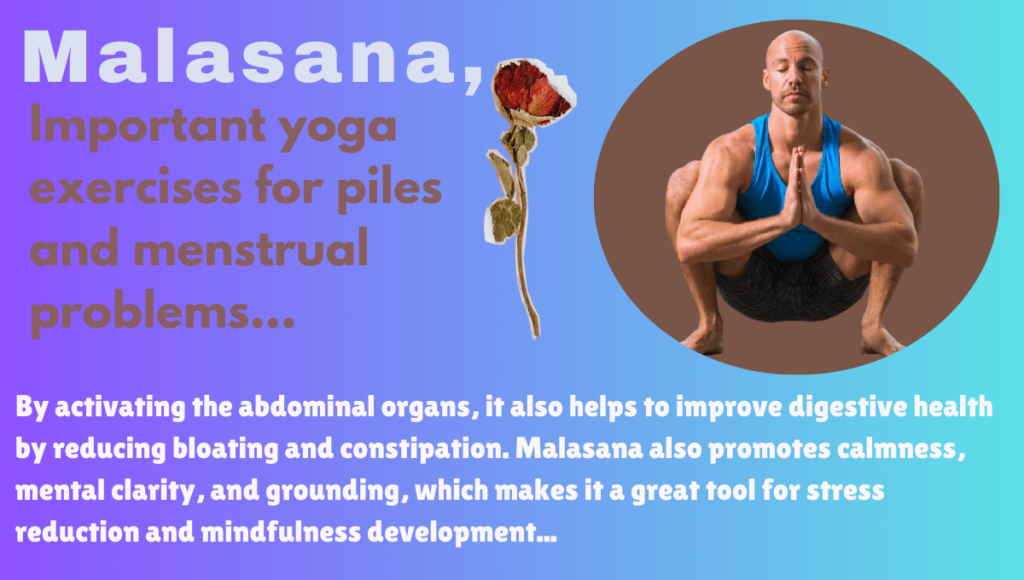Malasana’s Benefits___
What is Malasana(Garland Pose) ?
- Malasana, sometimes referred to as the “Yogic Squat” or “Garland Pose“, is a potent yoga pose that offers several advantages that go well beyond its straightforward appearance.
- An ancient asana known for its transforming powers on the body and mind is the deep squat, which involves lowering the body into a crouching stance with the knees spread apart and the hands in a prayer position.
- The “Malasana’s Benefits” are numerous and include strengthening the core, increasing balance and stability, and improving flexibility in the hips, ankles, and lower back. Malasana helps relieve lower back pain and stiffness by opening up and stretching the lower body.
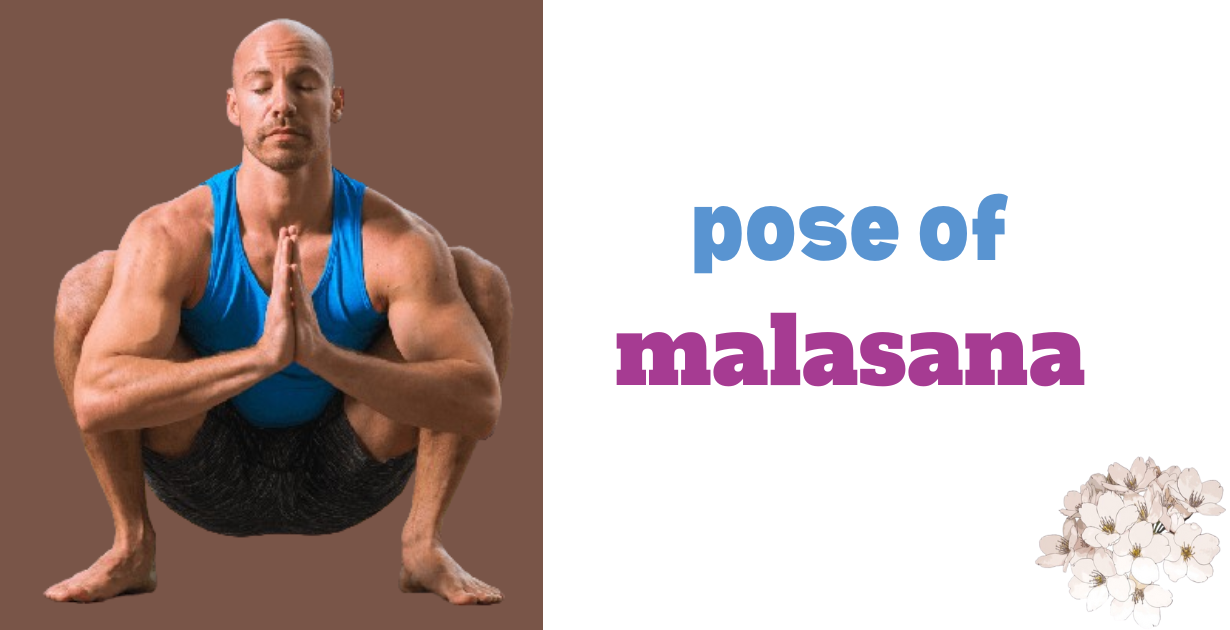
- The “Malasana’s Benefits” are numerous and include strengthening the pelvic muscles and core as well as improving flexibility in the lower back, hips, and ankles.
- Malasana is a great position for anyone trying to improve their general digestive health because it massages the abdominal organs and encourages good bowel movements, both of which can help with digestion.
- Malasana has mental and emotional advantages in addition to physical ones. It promotes steadiness and anchoring, which makes practitioners feel more at ease and in control.
- The “Malasana’s Benefits” are certainly amazing for anyone looking for a pose that offers a well-rounded approach to fitness. This strong squat pose can be a useful addition to any yoga practice, regardless of experience level, as it can help you develop more inner calm and physical strength.
Malasana: A blessing for Piles__
- One of the main “Malasana’s Benefits” is its beneficial effect on digestion; by regularly practicing this pose, you stimulate blood flow to the lower abdomen, which enhances digestion and prevents constipation, a major cause of piles; additionally, it stretches and strengthens the pelvic and hip muscles, creating space in the pelvic floor, which relieves pressure from hemorrhoids.

- Malasana, also known as the yogic squat pose, is an effective natural remedy for piles that can help with symptom relief and possibly prevent future problems.
- Squat with your feet close together, heels flat, and your hands clasped together at your chest in a prayer stance to execute Malasana.
- Maintaining a straight back while squatting, press your elbows into your knees to increase the stretch. Hold while taking deep breaths for 30 to 60 seconds.
- Daily Malasana practice eases discomfort, eases bowel motions, and lessens pile-related swelling. You can naturally lessen the symptoms of piles and greatly enhance your quality of life by incorporating this easy yet effective yoga practice.
Read more__
For Whom Is Malasana Practice Necessary ?
- The Garland Pose, also known as Malasana, is perfect for people who sit for extended periods of time and have stiff hips, knees, or ankles.
- Those who wish to increase their flexibility and expand their hips will especially benefit from it. Because it improves the pelvic floor muscles, this pose may also be beneficial for women who are pregnant or getting ready to give birth.
- Better digestion, increased lower body mobility, and alleviation of lower back discomfort are among the “Malasana’s Benefits”.
- Additionally, it is excellent for enhancing posture and balance. Nonetheless, cautious Malasana practice—possibly with modifications—is advised for those with knee issues.
A unique Malasana’s Benefits_(Flexibility of the Hips)__
- Improving hip flexibility is one of the main “Malasana’s Benefits”.
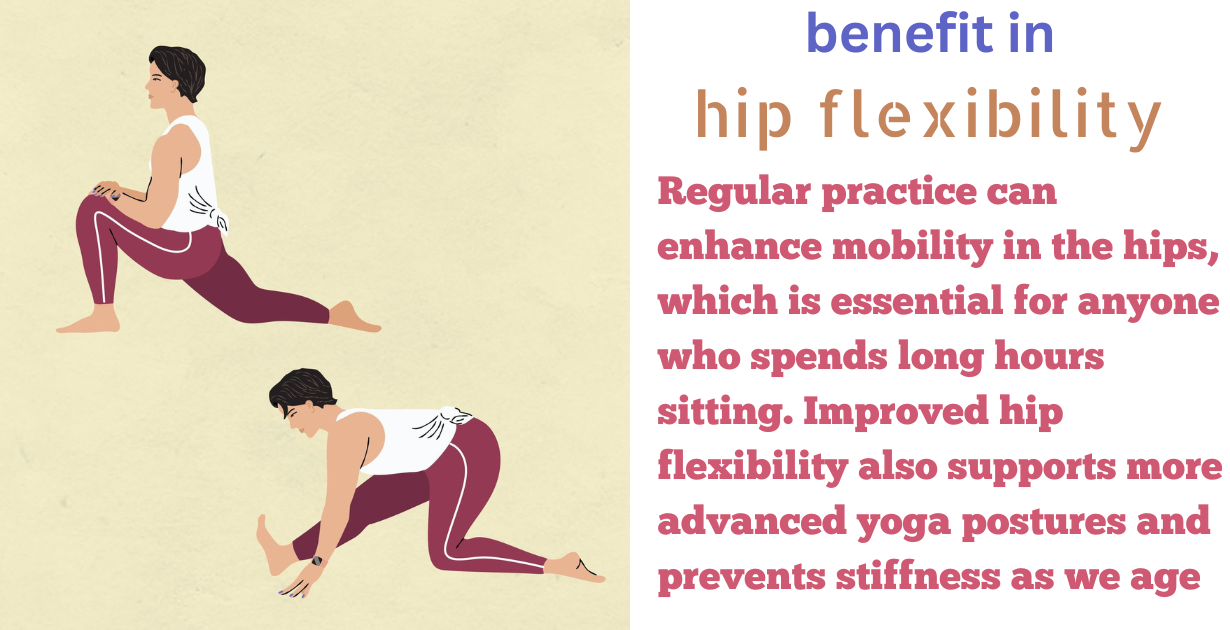
- Your hip joints are totally freed as you squat deeply into this position, which aids in releasing any tension or tightness.
- Frequent practice can improve hip mobility, which is crucial for anyone who sits for extended periods of time. Increased hip suppleness also helps with more difficult yoga poses and keeps our hips from getting stiff with age.
How to perform Malasana:
- A sequence of movements called “Malasana’s Benefits” are meant to help you attain the correct posture and reap the full advantages of the pose, also known as Garland Pose. Below is a detailed tutorial on how to achieve this advantageous pose:
- Beginning Point: Step one is to stand with your feet hip-width apart. Make sure your toes point slightly outward to follow your knees’ natural posture.
- Lowering Down: To enter a deep squat, gradually bend your knees and drop your hips toward the floor. Try to keep your heels as near to the ground as you can. Put a folded blanket or yoga block underneath your heels for support if they lift off the floor.
- Knee Adjustment: Spread your knees apart till they are in line with your toes. This lessens knee strain and helps to loosen up the hips.
- Bring Your Hands to Your Heart Center: Place your palms together at your heart center in a pose of prayer. To help extend your hips even more and deepen the stretch, gently press your elbows into your inner knees.
Preserve Alignment: Maintain a straight spine and an elevated chest. In order to be balanced and stable, contract your core. - Hold and Breathe: Hold the pose for a minute or thirty seconds, concentrating on taking steady, deep breaths. This makes it easier for you to reap the full benefits of the “Malasana’s Benefits”, which include increased digestion, groundedness, and flexibility.
- Release and Repeat: To exit the stance, extend your legs backward and stand up again. Repeat as long as you like, extending the time gradually as your comfort and flexibility increase.
- You may practice Malasana successfully and reap its many benefits—including stronger lower body, more flexible hips, and improved digestive health—by following these steps.
Some important Precautions about Practicing Malasana__
- The Garland Pose, also known as Malasana, is a helpful yoga pose that improves flexibility, strengthens the lower body, and raises consciousness. But it’s important to take specific precautions in order to prevent any hazards and enjoy the full “Malasana’s Benefits”.
- First and foremost, caution should be exercised when approaching Malasana if you have problems with your knees, hips, or lower back. The deep squatting position may make these issues worse. Props, such a yoga block or cushion under the heels, can ease tension and offer extra support.
- Before practicing Malasana, pregnant women should speak with their healthcare physician because deep squats may not be advised at all during several phases of pregnancy. In addition, unless they have medical clearance, people who have recently had surgery or sustained an injury should avoid this stance.
- To avoid damage, beginners should concentrate on maintaining correct alignment. As you lower yourself into the squat, make sure your feet are hip-width apart and maintain a straight spine. Maintaining stability and balance can be aided by using the core muscles.
- You can safely take advantage of the numerous “Malasana’s Benefits”, such as increased digestion, stronger legs, and more flexibility, by following these safety instructions.
Another Most Important “Malasana’s Benefits”__
- Garland Pose, sometimes referred to as Malasana, is a well-liked yoga pose that offers significant psychological and physical advantages.
- This pose, which is similar to a deep squat, enhances inner attention, flexibility, and balance. The following five major “Malasana’s Benefits” will greatly improve both your general health and yoga practice:

Makes the Lower Body Stronger
- Malasana focuses on the thighs, calves, and glutes, among other lower body muscles.
- Maintaining this squat stance causes your legs to contract forcefully, which gradually tones and strengthens these muscles.
- Because of this, Malasana is a great way to strengthen your lower body without using big weights or vigorous exercises.
Facilitates Digestion
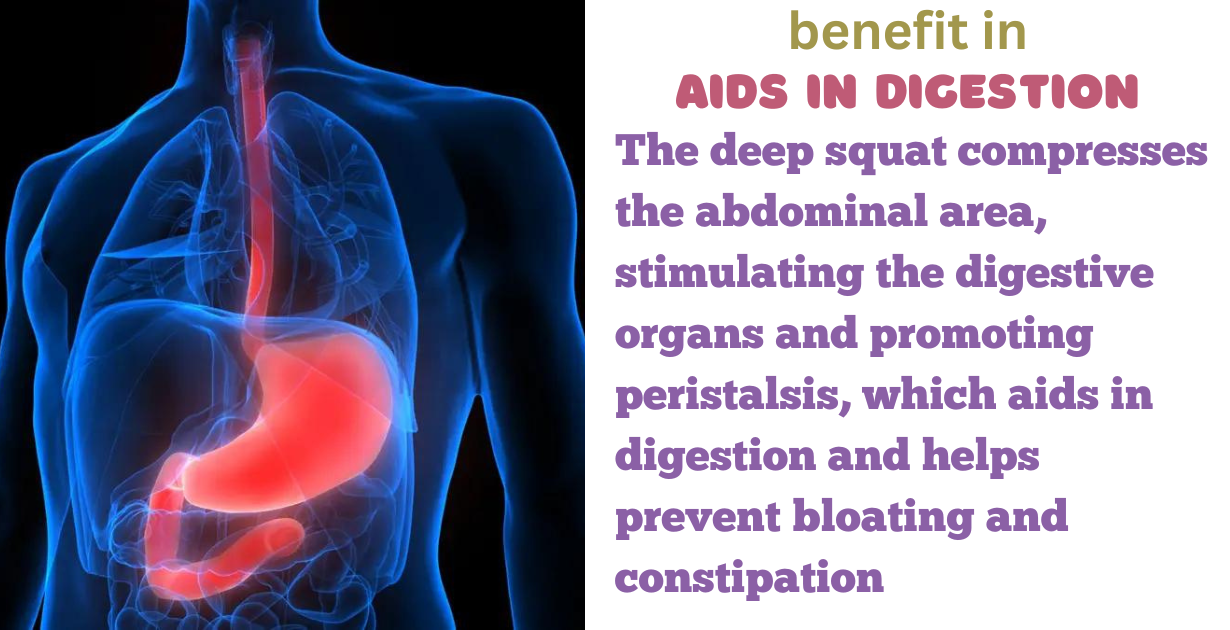
- Another often-overlooked “Malasana’s Benefits” is its positive impact on digestion.
- By compressing the abdomen region, the deep squat stimulates the digestive system and encourages peristalsis, which facilitates digestion and helps avoid bloating and constipation.
- Regularly performing Malasana can be especially helpful for people with digestive problems.
Enhances Balance and Posture
- Malasana assists with posture by activating your lower back and core muscles.
- It supports improved alignment in your daily activities and improves your spine by encouraging you to sit erect while keeping balance.
- This better alignment can lessen the chance of developing back pain and other alignment-related discomforts.
Calms the Thought
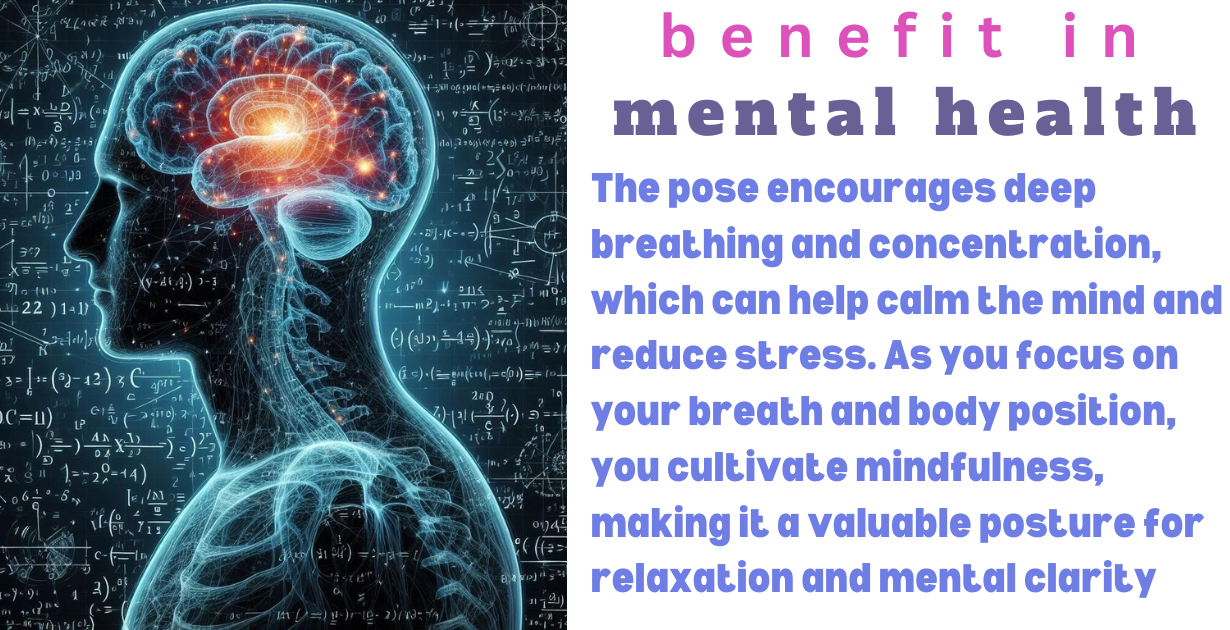
- Malasana has advantages for the mind as well. The stance promotes attention and deep breathing, which can ease mental tension and promote mental calmness.
- This posture is beneficial for relaxation and mental clarity since it cultivates mindfulness as you pay attention to your breath and body alignment.
- Finally, it should be noted that the “Malasana’s Benefits” go far beyond improved physical health and flexibility. From improved digestion to a calmer mind, this versatile pose is a valuable addition to any yoga practice.
Relieve Constipation and Bloating
- The “Malasana’s Benefits” go beyond improved physical health. For people with tight hips or sedentary lifestyles, this deep squat position is good because it greatly increases hip flexibility.
- Additionally, it stimulates the abdominal organs to aid in digestion, which helps to relieve constipation and bloating. Malasana also tones the lower body, especially the glutes, thighs, and calves.
- In terms of mental health, the posture promotes awareness and deep breathing, which ease tension and promote mental calmness. All things considered, Malasana promotes mental and physical health.
Conclusion:
In summary, there are many different and significant “Malasana’s Benefits”, which makes it a useful pose for anyone looking to enhance their physical and mental health. This deep squat strengthens the lower body muscles and core while improving flexibility in the hips, ankles, and lower back. By activating the abdominal organs, it also helps to improve digestive health by reducing bloating and constipation. Malasana also promotes calmness, mental clarity, and grounding, which makes it a great tool for stress reduction and mindfulness development. Including Malasana in your practice can improve your health tremendously.
FAQ:
- What is the “Malasana’s Benefits” ? Malasana offers numerous benefits, including improved digestion, reduced belly fat, enhanced mental excitement, relief from piles, spine problems, and knee issues.
- How long should Malasana be practiced? Practice Malasana according to your capacity, aiming for 5-10 cycles for young individuals and 2-5 cycles for older practitioners.
- How does Malasana help with piles? Malasana’s focus on the muscles around the anus makes it effective in treating piles and promoting overall health in this area.
- Which yoga exercise is best for knee problems? Malasana is considered one of the best yoga exercises for knee problems due to its focus on knee flexibility and strength.
- How does Malasana help during menstruation? Malasana’s strain on the lower waist and thighs affects hormone balance, providing relief from menstrual issues.

